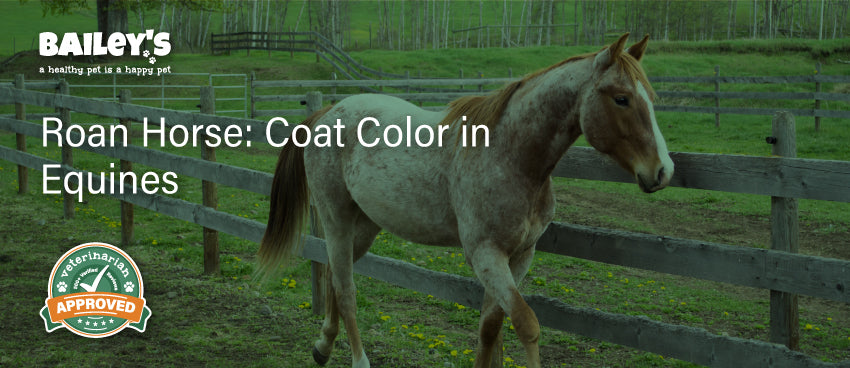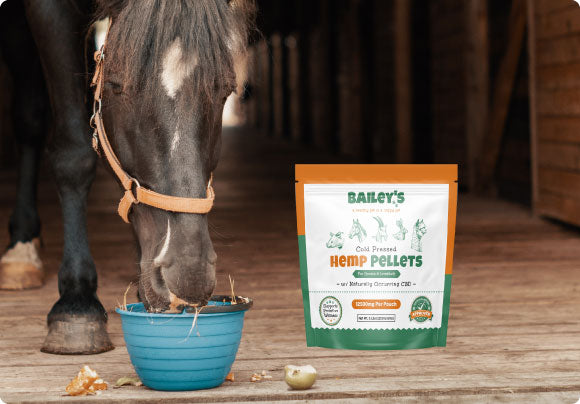Roan Horse: Coat Color in Equines

The coat color of horses is a fascinating subject and one that has captured the interest of horse enthusiasts and researchers alike. One particular coat color that stands out is the roan coat color. In this article, we will delve into the world of roan horses, exploring their genetics, history, breeding, health considerations, and even their presence in popular culture. Join us as we unravel the mysteries behind the captivating roan coat color.
This article explores the topic in detail so horse lovers can keep their pet healthy and happy.
For more information, check out Bailey’s CBD for Horses and discover additional products that promote well-being.
Understanding the Roan Coat Color
The roan coat color is a unique blend of white hairs mixed with colored hairs. This creates a speckled or mottled appearance, giving roan horses a striking and eye-catching look. The degree of roaning can vary, from a few scattered white hairs to nearly equal proportions of white and colored hairs. The most common colors that can be affected by the roan gene are bay, chestnut, and black.

Image: Roan-colored horse walking in front of sunset
Roan horses have long fascinated horse enthusiasts and breeders alike. Their captivating appearance and genetic makeup make them a subject of great interest and study. Let's delve deeper into the genetics and variations of the roan coat color.
RELATED ARTICLE: Learn More About Other Horse Breeds
The Genetics of Roan Coat Color
The roan coat color is a result of a specific genetic trait. It is inherited as an incomplete dominant trait, meaning that horses with one copy of the roan gene will display the roan coat color, while horses with two copies of the gene, known as homozygous roans, often have a more intense or solid roan coat.
Understanding the genetics behind the roan coat color involves unraveling the intricate mechanisms that govern pigment production and distribution in horses. The roan gene works by preventing the migration of pigment-producing cells to the growing hairs. This results in the interspersion of colored and white hairs throughout the horse's coat, creating the distinctive roan pattern.
Researchers and geneticists continue to explore the complexities of the roan gene, aiming to unravel its molecular mechanisms and gain a deeper understanding of its inheritance patterns. By studying the genetics of roan coat color, scientists hope to shed light on broader questions about pigmentation and gene regulation in horses.
RELATED ARTICLE: Learn and Essential Tips for a Balanced Diet 🐴
Variations of Roan Coat Color
Roan coat color can manifest in different variations, adding even more intrigue to these stunning horses. Some common variations include red roan, blue roan, and strawberry roan. Each variation has a unique blend of colored and white hairs, making every roan horse a truly one-of-a-kind beauty.
Red roan horses exhibit a blend of red or chestnut-colored hairs with white hairs, creating a warm and vibrant appearance. Blue roan horses, on the other hand, display a mix of black or dark-colored hairs with white hairs, resulting in a cool and striking contrast. Strawberry roan horses, as the name suggests, have a blend of reddish-brown hairs with white, resembling the color of ripe strawberries.
These variations in roan coat color not only add aesthetic appeal but also offer insights into the underlying genetic mechanisms at play. Researchers are actively studying these variations to uncover the specific genes and molecular pathways responsible for producing the different roan coat colors.
As we continue to explore the world of roan coat color, we gain a deeper appreciation for the intricate beauty and genetic diversity of these remarkable horses. From the fascinating genetics behind their coat color to the mesmerizing variations that make each roan horse unique, there is always more to discover and admire.
🌟 Related Equine Products 🌟

CBD Oil For Horses
Experience natural relief and enhanced wellness for your horse with Bailey's Vet-Crafted CBD Oil featuring a veterinary dosage chart.
Shop Bailey's Vet-Crafted CBD Oil For Horses
CBD Pellets For Horses
Provide your horse with the natural benefits of CBD in a convenient pellet form with Bailey's Vet-Crafted CBD Pellets.
Shop Bailey's Vet-Crafted CBD Pellets For HorsesThe History of Roan Horses
Roan horses have an intriguing history, dating back to ancient times. These horses have been admired for their unique coat color and have often held a special place in various cultures throughout history.
Roan horses, with their stunning blend of white and colored hairs, have fascinated horse enthusiasts for centuries. The origins of the roan coat color can be traced back to ancient civilizations, where these horses were highly regarded for their beauty and symbolism. They were often associated with nobility and power and were prized for their stand-out appearance.
In ancient artwork and tapestries, roan horses were frequently depicted, showcasing their regal presence. These magnificent creatures were admired by kings, rulers, and warriors, who believed that owning a roan horse brought good fortune and strength in battle.
Roan Horses in Ancient Times
In ancient times, roan horses were not only admired for their physical beauty but also revered for their symbolic significance. They were seen as a representation of grace, elegance, and majesty. The roan coat color was often associated with celestial beings and mythical creatures, further adding to their allure.
Throughout history, different civilizations held roan horses in high esteem. In ancient Egypt, for example, roan horses were considered sacred and were often associated with the sun god Ra. These horses were believed to possess divine qualities and were used in religious ceremonies and processions.
Similarly, in ancient Greece, roan horses were associated with the goddess Athena, who was the goddess of wisdom, courage, and warfare. It was believed that owning a roan horse would bring the rider protection and victory in battle.
Roan Horses in Modern Breeding
Roan horses continue to captivate breeders and enthusiasts in modern times. They are a sought-after coat color in various breeds, and many breeders strive to produce roan offspring. Through careful breeding and selection, modern horse breeders have managed to maintain and enhance the beauty of roan horses.
Today, roan horses can be found in various breeds, including Quarter Horses, Thoroughbreds, and Arabians. Breeders carefully select parent horses with the roan gene to ensure the continuation of this unique coat color. By combining genetics and advanced breeding techniques, breeders have been able to produce roan horses with even more vibrant and striking coats.
Roan horses are not only admired for their coat color but also for their versatility and temperament. They excel in various disciplines, including Western pleasure, dressage, and trail riding. Their gentle nature and willingness to please make them popular choices for riders of all skill levels.
As the demand for roan horses continues to grow, breeders and enthusiasts work together to preserve and promote these magnificent creatures. Roan horse shows and competitions are held worldwide, showcasing the beauty and elegance of these remarkable animals.
Breeding for Roan Coat Color
Breeding for the roan coat color requires a good understanding of genetics and inheritance patterns. The key to producing roan offspring lies in the presence of the roan gene in the breeding stock.
Roan horses, with their unique and captivating coat color, have always fascinated breeders and enthusiasts alike. The interplay of dominant and recessive genes in determining the roan coat color adds an element of complexity to the breeding process.
The Role of Dominant and Recessive Genes
Roan coat color is an incomplete dominant trait, which means that if one parent carries the roan gene, there is a chance that their offspring will have the roan coat color. However, it is important to note that not all roan offspring come from roan parents, as the gene can be passed down from previous generations.
When a horse inherits one copy of the roan gene, it will display the characteristic roan coat color, which is a mixture of white and colored hairs. On the other hand, if a horse inherits two copies of the roan gene, it may exhibit a more extreme form of roaning, known as "lethal white syndrome," which can be fatal. Breeders must be cautious when breeding two roan horses together to avoid this potentially devastating outcome.
In some cases, two roan horses may produce a solid-colored foal. This can happen when both parents are homozygous for the roan gene, resulting in a non-roan offspring. Understanding the genetics behind roan coat color is crucial for breeders who wish to produce consistent roan offspring.
Predicting Roan Offspring
Predicting the probability of producing roan offspring involves a basic understanding of Punnett squares. By examining the genetic makeup of both parents, breeders can determine the likelihood of producing roan foals, solid-colored foals, or carriers of the roan gene.
It is fascinating to delve into the intricacies of genetic inheritance and explore the various possibilities that arise when breeding for roan coat color. Breeders can utilize Punnett squares to visualize the different combinations of genes that can be passed down from parent to offspring. This allows them to make informed decisions and plan their breeding programs accordingly.
However, it is important to remember that breeding for roan coat color should always prioritize the health and well-being of the horses involved. Responsible breeding practices and proper care are essential to maintain a healthy population of roan horses. Breeders must consider not only the desired coat color but also the overall conformation, temperament, and soundness of the horses they are breeding.

Bailey's CBD Oil For Horses
- ✔ 1500mg CBD Per Bottle
- ✔ Comes With Vet Dosage Guide
- ✔ 3rd Party Lab Tested
- ✔ Made in California, USA
Health and Care Considerations for Roan Horses
As with any horse, roan horses require proper care and attention to ensure their well-being. While the roan coat color itself does not affect the horse's health, some health considerations are more commonly associated with roan horses. Consult with a veterinarian about utilizing supplements or implementing other health practices for the well-being of your roan horse.
Roan horses, with their unique coat coloration, possess a captivating beauty that sets them apart from other equine breeds. However, their stunning appearance comes with certain health considerations that owners should be aware of. One such concern is their increased susceptibility to skin sensitivity and sunburn due to the lighter pigmentation in their skin. This makes it crucial for owners to provide adequate protection from the sun's harmful rays.
When it comes to safeguarding roan horses from the sun, owners have a variety of options at their disposal. The use of fly sheets, which provide a physical barrier against the sun, can be highly effective. Additionally, fly masks not only protect the horse's eyes from irritating insects but also offer some degree of sun protection. To further shield the horse's sensitive skin, applying sunscreen to exposed areas can help prevent sunburn and potential discomfort.
Aside from the unique health considerations, roan horses also require regular grooming to maintain their vibrant appearance. Grooming not only keeps the coat clean and healthy but also helps establish a strong bond between the horse and its owner.
Common Health Issues in Roan Horses
Roan horses may be more prone to certain health issues such as skin sensitivity and sunburn due to the lighter pigmentation in their skin. This makes it important for owners to provide adequate protection from the sun, such as using fly sheets, fly masks, and sunscreen.
Related Article: CBD For Horses - Everything You Need To Know
While roan horses are generally healthy, owners must be vigilant and proactive in monitoring their horse's well-being. Regular check-ups with a veterinarian can help identify any potential health issues early on and ensure prompt treatment. Consult your veterinarian about the benefits of supplements to optimize your horse’s overall well-being.

Image: Expert Grooming of a Roan Horse: Enhancing Coat Beauty.
In addition to skin sensitivity and sunburn, roan horses may also be more susceptible to certain skin conditions. Owners need to be aware of any changes in the horse's skin, such as rashes, sores, or excessive itching. Prompt veterinary attention should be sought if any abnormalities are observed.
Grooming Tips for Roan Coats
Grooming plays a crucial role in maintaining the vibrant appearance of a roan coat. Regular grooming, including brushing, bathing, and conditioning, helps keep the coat clean and healthy. Additionally, avoiding harsh grooming tools, such as stiff brushes or curry combs, can help prevent hair breakage and preserve the roan coat's natural splendor.
When it comes to grooming a roan horse, it is important to approach it with care and gentleness. Using a soft-bristled brush or a grooming mitt can help remove dirt and debris without causing unnecessary stress to the horse. Regular bathing with a mild shampoo can help keep the coat clean and enhance its natural shine.
Conditioning the roan coat is also essential to maintain its lustrous appearance. Applying a quality equine conditioner after bathing can help keep the hair moisturized and prevent it from becoming dry or brittle. This is especially important for roan horses, as their unique coat color can lose its vibrancy if not properly cared for.
Roan Horses in Popular Culture
The captivating beauty of roan horses has not gone unnoticed in popular culture. These enchanting equines have made their presence known in literature, film, and even historical accounts.
Roan Horses in Literature and Film
Roan horses, with their unique and visually striking appearance, have captivated the imaginations of writers and filmmakers, making frequent appearances in literature and on the silver screen. Their distinct coat patterns add a layer of depth and intrigue to various narratives, showcasing the undeniable allure of these stunning creatures.
- Classical Literature: In classic literary works, roan horses often symbolize nobility and bravery. For instance, in Sir Walter Scott's "Ivanhoe," the character of Richard the Lionheart rides a powerful roan horse, embodying the king's heroic and regal nature.
- Children's Literature: Roan horses also feature in children's stories, enchanting younger audiences with their mystical appearance. In Marguerite Henry's "Misty of Chincoteague," a roan pony plays a central role, capturing the hearts of children with its spirited nature and beautiful coat.
- Westerns and Adventure Films: In the realm of cinema, roan horses have been a staple in Western and adventure genres. Their striking presence adds authenticity and visual appeal to the rugged landscapes of these films. A notable example is the movie "True Grit," where a roan horse enhances the gritty and resilient atmosphere of the story.
- Fantasy and Mythology: Roan horses have also found their place in fantasy literature and films. Their ethereal and unusual coloring lends itself well to stories of magic and myth. In "The Lord of the Rings" series, roan horses carry the mystical elves, symbolizing their connection to nature and the enchanted world.
- Documentaries and Historical Dramas: Documentaries and historical dramas use roan horses to bring authenticity to historical reenactments and narratives. Their presence helps to accurately depict the breeds and colors of horses used throughout history, providing viewers with a more immersive experience.
By featuring in literature and film, roan horses bridge the gap between reality and fantasy, allowing audiences to connect with these majestic animals in a myriad of ways. From the pages of historical novels to the grandeur of the cinema, roan horses continue to be a symbol of beauty, strength, and inspiration. Famous Roan Horses in History Throughout history, several notable roan horses have left indelible marks in the annals of time. From legendary warhorses that galloped through battlefields to the cherished mounts of renowned historical figures, these roan horses have become iconic symbols of strength, grace, and beauty. Let's delve deeper into some of these remarkable equines:
- Warhorse Legends: One of the most famous roan warhorses was "Traveller," the trusted steed of General Robert E. Lee during the American Civil War. Known for his speed, strength, and courage, Traveller carried Lee to many pivotal battles, becoming a symbol of Confederate history.
- Famous Riders and Their Roan Companions: A notable historical figure with a roan mount was Catherine the Great of Russia. Her beloved roan horse, "Brilliant," was celebrated for its majestic appearance and was often depicted in contemporary paintings, symbolizing the empress's power and elegance.
- Cultural Impact: Roan horses have been immortalized in various artworks, such as the Renaissance paintings depicting noble knights on their roan chargers. These images have contributed to the romanticized view of the medieval era and the valor associated with these noble steeds.
- Rare Breeds and Their Stories: The Blue Roan Mustangs of the American West are a testament to the enduring legacy of roan horses. Descended from Spanish horses, these mustangs are known for their striking blue roan coats and have become a symbol of the untamed beauty of the American wilderness.
- Conservation Efforts: Today, the preservation of roan horse breeds, such as the Blue Roan Mustang, is crucial. Organizations like the Mustang Heritage Foundation work tirelessly to protect these horses, ensuring that the legacy of these magnificent creatures continues for future generations.
By understanding these remarkable horses, we gain insights into our history and the roles these magnificent creatures have played. The legacy of roan horses is not only a tale of their physical beauty but also a story of their impact on human lives and cultures across the globe.
Conclusion
The roan coat color in horses is a captivating and multifaceted subject. From the fascinating genetics behind this unique coat color to its historical significance and presence in popular culture, roan horses continue to captivate the hearts of horse lovers worldwide. With proper care and responsible breeding practices, we can ensure the preservation and appreciation of these breathtaking equines for generations to come.
These products have not been evaluated by the FDA and are not intended to diagnose, treat, cure, or prevent any disease.












